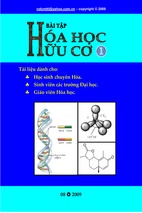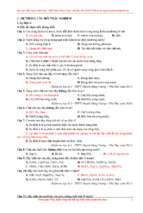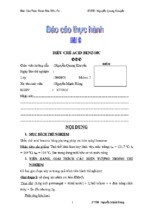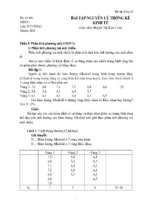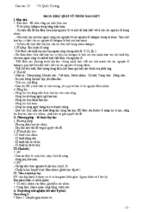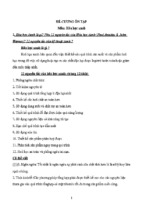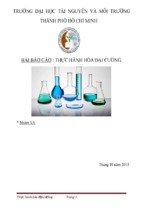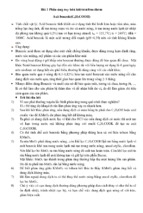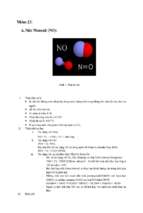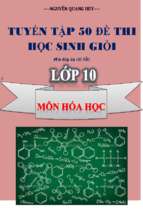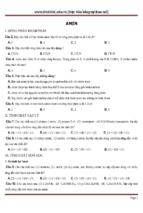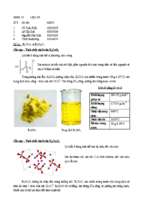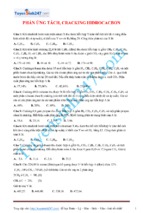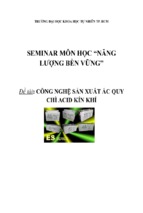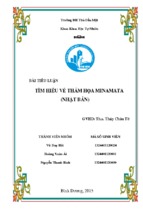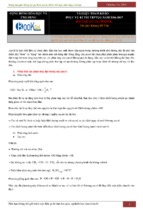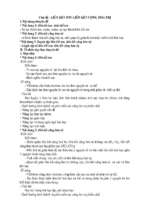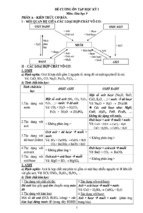Chemical Reactions and Chemical Reactors - George W. Roberts
Chemical Reactions and Chemical Reactors
This page intentionally left blank
Chemical Reactions and
Chemical Reactors
George W. Roberts
North Carolina State University
Department of Chemical and Biomolecular Engineering
�
WILEY
John Wiley & Sons, Inc.
VICE PRESIDENT AND EXECUTIVE PUBLISHER
Don Fowley
ASSOCIATE PUBLISHER
Dan Sayre
ACQUISITIONS EDITOR
Jenny Welter
VICE PRESIDENT AND DIRECTOR OF MARKETING
Susan Elbe
EXECUTIVE MARKETING MANAGER
Chris Ruel
SENIOR PRODUCTION EDITOR
Trish McFadden
DESIGNER
Michael St. Martine
PRODUCTION MANAGEMENT SERVICES
Thomson Digital Limited
EDITORIAL ASSISTANT
Mark Owens
MARKETING ASSISTANT
Chelsee Pengal
MEDIA EDITOR
Lauren Sapira
© Taylor Kennedy/NG Image Collection
COVER PHOTO
Cover Description:
The firefly on the cover is demonstrating the phenomenon of "bioluminescence", the production of light within
an organism (the reactor) by means of a chemical reaction. In addition to fireflies, certain marine animals also
exhibit bioluminescence.
In the firefly, a reactant or substrate known as "firefly luciferin" reacts with 02 and adenosine triphosphate
(ATP) in the presence of an enzyme catalyst, luciferase, to produce a reactive intermediate (a four-member
cyclic perester).
Firefly luciferin + ATP+ 02
Iuciferase
Intermediate
The intermediate then loses C02 spontaneously to form a heterocyclic intermediate known as "oxyluciferin".
As formed, the oxyluciferin is in an excited state, i.e., there is an electron in an anti-bonding orbital.
Intermediate� Oxyluciferin* + C02
Finally, oxyluciferin decays to its ground state with the emission of light when the excited electron drops into a
bonding orbital.
Oxyluciferin* � Oxyluciferin + hv (light)
This series of reactions is of practical significance to both fireflies and humans. It appears that firefly larvae use
bioluminescense to discourage potential predators. Some adult fireflies use the phenomenon to attract members
of the opposite sex.
In the human world, the reaction is used to assay for ATP, a very important biological molecule. Concentrations
11
M can be detected by measuring the quantity of light emitted. Moreover, medical
of ATP as low as 10-
researchers have implanted the firefly's light-producing gene into cells inside other animals and used the
resulting bioluminescense to track those cells in the animal's body. This technique can be extended to cancer
cells, where the intensity of the bioluminescense can signal the effectiveness of a treatment. Finally, the energy
released by the bioluminescense-producing reactions is almost quantitatively converted into light. In contrast,
only about 10% of the energy that goes into a conventional incandescent light bulb is converted into light.
This book was set in Times New Roman by Thomson Digital Limited and printed and bound by Hamilton
Printing. The cover was printed by Phoenix Color.
This book is printed on acid free paper.
@
Copyright© 2009 John Wiley & Sons, Inc. All rights reserved. No part of this publication may be reproduced,
stored in a retrieval system or transmitted in any form or by any means, electronic, mechanical, photocopying,
recording, scanning or otherwise, except as permitted under Sections 107 or 108 of the 1976 United States
Copyright Act, without either the prior written permission of the Publisher, or authorization through payment of
the appropriate per-copy fee to the Copyright Clearance Center, Inc. 222 Rosewood Drive, Danvers, MA 01923,
website www.copyright.com. Requests to the Publisher for permission should be addressed to the Permissions
Department, John Wiley & Sons, Inc., 111 River Street, Hoboken, NJ 07030-5774, (201)748-6011, fax
(201)748-6008, website http://www.wiley.com/go/permissions.
To order books or for customer service please, call 1-800-CALL WILEY (225-5945).
ISBN-13 978-0471-7 42203
Printed in the United States of America
10
9
8
7
6
5
4
3
2
1
Contents
1.
Reactions and Reaction Rates
1.1
Introduction
1.1.1
1
1
The Role of Chemical Reactions
1.1.2
Chemical Kinetics
1.1.3
Chemical Reactors
1
2
2
3
1.2
Stoichiometric Notation
1.3
Extent of Reaction and the Law of Definite Proportions
1.4
Definitions of Reaction Rate
1.3.1
1.4.1
Stoichiometric Notation-Multiple Reactions
Species-Dependent Definition
1.4.1.1
Single Fluid Phase
1.4.1.2
Multiple Phases
8
9
9
Other Cases
1.4.1.3
Relationship between Reaction Rates of Various Species
1.4.1.4
Multiple Reactions
10
11
12
12
Reaction Rates-Some Generalizations
2.1
Rate Equations
2.2
Five Generalizations
2.3
An Important Exception
Problems
17
33
33
33
Ideal Reactors
36
3.1
Generalized Material Balance
3.2
Ideal Batch Reactor
3.3
Continuous Reactors
3.4
16
16
Summary of Important Concepts
3.
11
Species-Independent Definition
Summary of Important Concepts
2.
36
38
43
3.3.1
Ideal Continuous Stirred-Tank Reactor (CSTR)
3.3.2
Ideal Continuous Plug-Flow Reactor (PFR)
3.3.2.1
The Easy Way-Choose a Different Control Volume
3.3.2.2
The Hard Way-Do the Triple Integration
Summary of Important Concepts
54
57
Sizing and Analysis of Ideal Reactors
Homogeneous Reactions
4.1.1
51
54
57
Appendix 3 Summary of Design Equations
4.1
45
49
Graphical Interpretation of the Design Equations
Problems
4.
9
10
(Single Reaction)
Problems
6
8
Heterogeneous Catalysis
1.4.2
4
Batch Reactors
60
63
63
63
4.1.1.1
Jumping Right In
4.1.1.2
General Discussion: Constant-Volume Systems
63
Describing the Progress of a Reaction
Solving the Design Equation
68
68
71
v
vi
Contents
4.1.1.3
4.1.2
4.1.2.1
74
General Discussion: Variable-Volume Systems
77
Continuous Reactors
78
Continuous Stirred-Tank Reactors (CSTRs)
78
Constant-Density Systems
Variable-Density (Variable-Volume) Systems
4.1.2.2
80
82
Plug-Flow Reactors
Constant-Density (Constant-Volume) Systems
Variable-Density (Variable-Volume) Systems
4.1.2.3
Graphical Solution of the CSTR Design Equation
4.1.2.4
Biochemical Engineering Nomenclature
82
84
86
90
4.2
Heterogeneous Catalytic Reactions (Introduction to Transport Effects)
4.3
Systems of Continuous Reactors
4.3.1
4.3.2
4.3.3
4.4
97
98
Reactors in Series
98
103
4.3.1.1
CSTRs in Series
4.3.1.2
PFRs in Series
4.3.1.3
PFRs and CSTRs in Series
103
107
Reactors in Parallel
4.3.2.1
CSTRs in Parallel
4.3.2.2
PFRs in Parallel
107
109
110
Generalizations
111
Recycle
114
Summary of Important Concepts
Problems
114
Appendix 4 Solution to Example 4-10: Three Equal-Volume CSTRs in Series
5.
Reaction Rate Fundamentals (Chemical Kinetics)
5.1
5.2
123
Significance
125
5.1.2
Definition
5.1.3
Screening Criteria
126
130
5.2.1
Open Sequences
5.2.2
Closed Sequences
130
5.3
The Steady-State Approximation (SSA)
131
Use of the Steady-State Approximation
133
5.4.1
Kinetics and Mechanism
5.4.2
The Long-Chain Approximation
136
137
5.5
Closed Sequences with a Catalyst
5.6
The Rate-Limiting Step (RLS) Approximation
138
5.6.1
Vector Representation
5.6.2
Use of the RLS Approximation
5.6.3
Physical Interpretation of the Rate Equation
5.6.4
Irreversibility
Closing Comments
142
143
147
147
148
Analysis and Correlation of Kinetic Data
6.1
140
141
145
Summary of Important Concepts
Problems
6.
129
Sequences of Elementary Reactions
5.4
5.7
123
123
Elementary Reactions
5.1.1
91
Experimental Data from Ideal Reactors
6.1.1
Stirred-Tank Reactors (CSTRs)
6.1.2
Plug-Flow Reactors
6.1.2.1
154
154
155
156
Differential Plug-Flow Reactors
156
122
Contents
6.1.2.2
6.2
Integral Plug-Flow Reactors
Batch Reactors
6.1.4
Differentiation of Data: An Illustration
158
162
Rate Equations Containing Only One Concentration
162
6.2.1.1
Testing a Rate Equation
6.2.1.2
Linearization of Langmuir-Hinshelwood/Michaelis-Menten
162
165
6.2.2
Rate Equations Containing More Than One Concentration
6.2.3
Testing the Arrhenius Relationship
6.2.4
Nonlinear Regression
171
Using the Integral Method
173
173
6.3.2
Linearization
6.3.3
Comparison of Methods for Data Analysis
176
Elementary Statistical Methods
6.4.1
178
First Hypothesis: First-Order Rate Equation
179
179
Residual Plots
Parity Plots
6.4.1.2
177
178
Fructose Isomerization
6.4.1.1
180
Second Hypothesis: Michaelis-Menten Rate Equation
Constants in the Rate Equation: Error Analysis
Non-Linear Least Squares
6.4.2
186
Rate Equations Containing More Than One Concentration
(Reprise)
186
Summary of Important Concepts
Problems
187
188
Appendix 6-A Nonlinear Regression for AIBN Decomposition
197
Appendix 6-B Nonlinear Regression for AIBN Decomposition
198
Appendix 6-C Analysis of Michaelis-Menten Rate Equation via
Lineweaver-Burke Plot Basic Calculations
7.
201
Multiple Reactions
201
7.1
Introduction
7.2
Conversion, Selectivity, and Yield
7.3
Classification of Reactions
7.4
203
208
7.3.1
Parallel Reactions
7.3.2
Independent Reactions
7.3.3
Series (Consecutive) Reactions
7.3.4
Mixed Series and Parallel Reactions
Reactor Design and Analysis
208
208
209
209
211
211
7.4.1
Overview
7.4.2
Series (Consecutive) Reactions
7.4.3
212
212
7.4.2.1
Qualitative Analysis
7.4.2.2
Time-Independent Analysis
7.4.2.3
Quantitative Analysis
7.4.2.4
Series Reactions in a CSTR
214
215
218
Material Balance on A
219
Material Balance on R
219
220
Parallel and Independent Reactions
7.4.3.1
166
169
The Integral Method of Data Analysis
6.3.1
6.4
159
The Differential Method of Data Analysis
Rate Equations
6.3
157
6.1.3
6.2.1
vii
Qualitative Analysis
Effect of Temperature
220
221
199
181
184
viii
Contents
Effect of Reactant Concentrations
7.4.3.2
7.4.4
Quantitative Analysis
Qualitative Analysis
7.4.4.2
Quantitative Analysis
Summary of Important Concepts
Problems
224
230
Mixed Series/Parallel Reactions
7.4.4.1
222
230
231
232
232
Appendix 7-A Numerical Solution of Ordinary Differential Equations
7-A.1 Single, First-Order Ordinary Differential Equation
241
241
7-A.2 Simultaneous, First-Order, Ordinary Differential Equations
8.
251
Use of the Energy Balance in Reactor Sizing and Analysis
251
8.1
Introduction
8.2
Macroscopic Energy Balances
8.2.1
8.2.2
Single Reactors
8.2.1.2
Reactors in Series
255
Adiabatic Reactors
257
261
8.4.1
Exothermic Reactions
8.4.2
Endothermic Reactions
8.4.3
Adiabatic Temperature Change
8.4.4
Graphical Analysis of Equilibrium-Limited Adiabatic
8.4.5
Kinetically Limited Adiabatic Reactors (Batch and Plug Flow)
Reactors
261
262
264
266
Continuous Stirred-Tank Reactors (General Treatment)
8.5.1
271
Simultaneous Solution of the Design Equation and the
Energy Balance
272
8.5.2
Multiple Steady States
8.5.3
Reactor Stability
8.5.4
Blowout and Hysteresis
8.5.4.1
276
277
279
279
Blowout
Extension
281
282
Discussion
8.5.4.2
8.8
255
Macroscopic Energy Balance for Batch Reactors
8.4
8.7
254
Macroscopic Energy Balance for Flow Reactors (PFRs and
Isothermal Reactors
8.6
252
252
8.2.1.1
8.3
8.5
252
Generalized Macroscopic Energy Balance
CSTRs)
8.2.3
245
Feed-Temperature Hysteresis
282
Nonisothermal, Nonadiabatic Batch, and Plug-Flow Reactors
8.6.1
General Remarks
8.6.2
Nonadiabatic Batch Reactors
284
284
Feed/Product (F/P) Heat Exchangers
8.7.1
Qualitative Considerations
8.7.2
Quantitative Analysis
285
285
286
8.7.2.1
Energy Balance-Reactor
8.7.2.2
Design Equation
288
288
8.7.2.3
Energy Balance-PIP Heat Exchanger
8.7.2.4
Overall Solution
8.7.2.5
Adjusting the Outlet Conversion
8.7.2.6
Multiple Steady States
Concluding Remarks
291
294
Summary of Important Concepts
295
292
291
289
284
268
Contents
Problems
296
Appendix 8-A Numerical Solution to Equation (8-26)
Appendix 8-B Calculation of
9.
302
G(T) and R(T) for "Blowout" Example
Heterogeneous Catalysis Revisited
9.1
Introduction
The Structure of Heterogeneous Catalysts
305
306
9.2.1
Overview
9.2.2
Characterization of Catalyst Structure
306
9.2.2.1
Basic Definitions
9.2.2.2
Model of Catalyst Structure
Internal Transport
310
310
311
311
9.3.1
General Approach-Single Reaction
9.3.2
An Illustration: First-Order, Irreversible Reaction in an Isothermal,
9.3.3
Extension to Other Reaction Orders and Particle Geometries
9.3.4
The Effective Diffusion Coefficient
Spherical Catalyst Particle
311
314
318
9.3.4.1
Overview
9.3.4.2
Mechanisms of Diffusion
319
Bulk (Molecular) Diffusion
The Transition Region
319
320
Knudsen Diffusion (Gases)
321
323
Concentration Dependence
9.3.4.3
The Effect of Pore Size
323
325
Narrow Pore-Size Distribution
Broad Pore-Size Distribution
325
326
9.3.5
Use of the Effectiveness Factor in Reactor Design and Analysis
9.3.6
Diagnosing Internal Transport Limitations in Experimental
Disguised Kinetics
328
Effect of Concentration
329
329
Effect of Temperature
330
Effect of Particle Size
9.3.7
9.3.8
9.3.6.2
The Weisz Modulus
9.3.6.3
Diagnostic Experiments
331
333
335
Internal Temperature Gradients
Reaction Selectivity
340
9.3.8.1
Parallel Reactions
9.3.8.2
Independent Reactions
9.3.8.3
Series Reactions
External Transport
9.4.1
340
342
344
346
General Analysis-Single Reaction
9.4.1.1
9.4.1.2
326
328
Studies
9.3.6.1
315
318
Configurational (Restricted) Diffusion
9.4
304
305
9.2
9 .3
ix
346
Quantitative Descriptions of Mass and Heat Transport
Mass Transfer
347
Heat Transfer
347
347
First-Order, Reaction in an Isothermal Catalyst Particle-The
Concept of a Controlling Step
'Y}kvlc/kc «
'Y}kvlc/kc »
1
349
1
350
348
9.4.1.3
Effect of Temperature
9.4.1.4
Temperature Difference Between Bulk Fluid and Catalyst
Surface
354
353
x
Contents
9.4.2
9.4.3
9.4.4
9.5
Diagnostic Experiments
356
9.4.2.1
Fixed-Bed Reactor
9.4.2.2
Other Reactors
357
361
Calculations of External Transport
362
9.4.3.1
Mass-Transfer Coefficients
9.4.3.2
Different Definitions of the Mass-Transfer Coefficient
9.4.3.3
Use of Correlations
Reaction Selectivity
366
Catalyst Design-Some Final Thoughts
368
369
369
Problems
376
Appendix 9-A Solution to Equation (9-4c)
'Nonideal' Reactors
10.1
10.2
378
What Can Make a Reactor "Nonideal"?
10.1.1
What Makes PFRs and CSTRs "Ideal"?
Nonideal Reactors: Some Examples
378
379
10.1.2.1
Tubular Reactor with Bypassing
10.1.2.2
Stirred Reactor with Incomplete Mixing
10.1.2.3
Laminar Flow Tubular Reactor (LFTR)
379
Diagnosing and Characterizing Nonideal Flow
380
380
381
10.2.1
Tracer Response Techniques
10.2.2
Tracer Response Curves for Ideal Reactors
(Qualitative Discussion)
10.3
378
10.1.2
10.2.3
381
383
10.2.2.1
Ideal Plug-How Reactor
10.2.2.2
Ideal Continuous Stirred-Tank Reactor
384
Tracer Response Curves for Nonideal Reactors
385
383
10.2.3.1
Laminar Flow Tubular Reactor
10.2.3.2
Tubular Reactor with Bypassing
10.2.3.3
Stirred Reactor with Incomplete Mixing
Residence Time Distributions
385
385
386
387
10.3.1
The Exit-Age Distribution Function,
10.3.2
Obtaining the Exit-Age Distribution from Tracer Response
Curves
10.3.3
387
E(t)
389
Other Residence Time Distribution Functions
391
10.3.3.1
Cumulative Exit-Age Distribution Function, F(t)
10.3.3.2 Relationship between F(t) and E(t)
392
10.3.3.3 Internal-Age Distribution Function, l(t)
392
10.3.4
10.4
Ideal Plug-Flow Reactor
10.3.4.2
Ideal Continuous Stirred-Tank Reactor
391
393
Residence Time Distributions for Ideal Reactors
10.3.4.1
393
395
Estimating Reactor Performance from the Exit-Age Distribution-The
Macrofluid Model
397
10.4.1
The Macrofluid Model
10.4.2
Predicting Reactor Behavior with the Macrofluid Model
10.4.3
Using the Macrofluid Model to Calculate Limits of
Performance
10.5
365
368
Summary of Important Concepts
10.
362
397
403
Other Models for Nonideal Reactors
10.5.1
404
Moments of Residence Time Distributions
10.5.1.1
Definitions
10.5.1.2
The First Moment of
404
E(t)
405
404
398
Contents
405
Average Residence Time
Reactor Diagnosis
406
10.5.1.3
The Second Moment of E(t)-Mixing
10.5.1.4
Moments for Vessels in Series
407
408
412
The Dispersion Model
10.5.2
412
10.5.2.1
Overview
10.5.2.2
The Reaction Rate Term
413
413
Homogeneous Reaction
415
Heterogeneous Catalytic Reaction
10.5.2.3
415
Solutions to the Dispersion Model
Rigorous
415
Approximate (Small Values of D/uL)
10.5.2.4
Estimating D/uL from Correlations
417
Criterion for Negligible Dispersion
419
420
The Dispersion Model-Some Final Comments
CSTRs-In-Series (CIS) Model
10.5.3
422
Overview
10.5.3.2
Determining the Value of "N"
10.5.3.3
Calculating Reactor Performance
Compartment Models
426
Overview
10.5.4.2
Compartment Models Based on CSTRs and PFRs
Reactors in Series
Concluding Remarks
435
Problems
Nomenclature
446
440
427
429
Well-Mixed Stagnant Zones
434
Summary of Important Concepts
Index
424
426
Reactors in Parallel
10.6
423
10.5.4.1
10.5.4.3
422
422
10.5.3.1
10.5.4
417
417
The Dispersion Number
Measurement of D/uL
10.5.2.5
xi
435
431
427
Preface
Intended Audience
This text covers the topics that are treated in a typical, one-semester undergraduate course in
chemical reaction engineering. Such a course is taught in almost every chemical engineer
ing curriculum, internationally. The last three chapters of the book extend into topics that
may also be suitable for graduate-level courses.
Goals
Every engineering text that is intended for use by undergraduates must address two needs.
First, it must prepare students to function effectively in industry with only the B.S.
degree. Second, it must prepare those students that go to graduate school for advanced
coursework in reaction kinetics and reactor analysis. Most of the available textbooks fall
short of meeting one or both of these requirements. "Chemical Reactions and Chemical
Reactors" addresses both objectives. In particular:
Focus on Fundamentals: The text contains much more on the fundamentals of chemical
kinetics than current books with a similar target audience. The present material on
kinetics provides an important foundation for advanced courses in chemical kinetics.
Other books combine fundamentals and advanced kinetics in one book, making it difficult
for students to know what's important in their first course.
Emphasis on Numerical Methods: The book emphasizes the use of numerical methods to
solve reaction engineering problems. This emphasis prepares the student for graduate
coursework in reactor design and analysis, coursework that is more mathematical in nature.
Analysis of Kinetic Data: Material on the analysis of kinetic data prepares students for
the research that is a major component of graduate study. Simultaneously, it prepares
students who will work in plants and pilot plants for a very important aspect of their job.
These features are discussed in more detail below.
"Chemical Reactions and Chemical Reactors" is intended as a text from which to teach.
Its objective is to help the student master the material that is presented. The following
characteristics aid in this goal:
Conversational Tone: The tone of the book is conversational, rather than scholarly.
Emphasis on Solving Problems: The emphasis is on the solution of problems, and the
text contains many example problems, questions for discussion, and appendices. Very few
derivations and proofs are required of the student. The approach to problem-solving is to
start each new problem from first principles. No attempt is made to train the student to
use pre-prepared charts and graphs.
Use of Real Chemistry: Real chemistry is used in many of the examples and problems.
Generally, there is a brief discussion of the practical significance of each reaction that is
introduced. Thus, the book tries to teach a little industrial chemistry along with chemical
kinetics and chemical reactor analysis. Unfortunately, it is difficult to find real-life
examples to illustrate all of the important concepts. This is particularly true in a
discussion of reactors in which only one reaction takes place. There
are
several important
principles that must be illustrated in such a discussion, including how to handle reactions
with different stoichiometries and how to handle changes in the mass density as the
reaction takes place. It was not efficient to deal with all of these variations through real
xii
Preface
xiii
examples, in part because rate equations are not openly available. Therefore, in some
cases, it has been necessary to revert to generalized reactions.
Motivation and Differentiating Features
Why is a new text necessary, or even desirable? After all, the type of course described in
the first paragraph has been taught for decades, and a dozen or so textbooks are available
to support
such
courses.
"Chemical Reactions and Chemical
Reactors"
differs
substantially in many important respects from the books that are presently available.
On a conceptual level, this text might be regarded as a fusion of two of the most
influential (at least for this author) books of the past fifty years: Octave Levenspiel's
"Chemical Reaction Engineering"
and Michel Boudart's
"Kinetics of Chemical
Processes." As suggested by these two titles, one of the objectives of this text is to
integrate a fundamental understanding of reaction kinetics with the application of the
principles of kinetics to the design and analysis of chemical reactors. However, this text
goes well beyond either of these earlier books, both of which first appeared more than
forty years ago, at the dawn of the computer era.
This text is differentiated from the reaction engineering books that currently are
available in one or more of the following respects:
1. The field of chemical kinetics is treated in some depth, in an integrated fashion that
emphasizes the fundamental tools of kinetic analysis, and challenges the student to
apply these common tools to problems in many different areas of chemistry and
biochemistry.
2. Heterogeneous catalysis is introduced early in the book. The student can then solve
reaction engineering problems involving heterogeneous catalysts, in parallel with
problems involving homogeneous reactions.
3. The subject of transport effects in heterogeneous catalysis is treated in significantly
greater depth.
4. The analysis of experimental data to develop rate equations receives substantial
attention; a whole chapter is devoted to this topic.
5. The text contains many problems and examples that require the use of numerical
techniques.
The integration of these five elements into the text is outlined below.
Topical Organization
Chapter 1 begins with a review of the stoichiometry of chemical reactions, which leads
into a discussion of various definitions of the reaction rate. Both homogeneous and
heterogeneous systems are treated. The material in this chapter recurs throughout the
book, and is particularly useful in Chapter 7, which deals with multiple reactions.
Chapter 2 is an "overview" of rate equations. At this point in the text, the subject of
reaction kinetics is approached primarily from an empirical standpoint, with emphasis on
power-law rate equations, the Arrhenius relationship, and reversible reactions (thermo
dynamic consistency). However, there is some discussion of collision theory and
transition-state theory, to put the empiricism into a more fundamental context. The intent
of this chapter is to provide enough information about rate equations to allow the student
to understand the derivations of the "design equations" for ideal reactors, and to solve
some problems in reactor design and analysis. A more fundamental treatment of reaction
kinetics is deferred until Chapter 5. The discussion of thermodynamic consistency
xiv
Preface
includes a "disguised" review of the parts of chemical thermodynamics that will be
required later in the book to analyze the behavior of reversible reactions.
The definitions of the three ideal reactors, and the fundamentals of ideal reactor
sizing and analysis are covered in Chapters 3 and 4. Graphical interpretation of the
"design equations" (the "Levenspiel plot") is used to compare the behavior of the two
ideal continuous reactors, the plug flow and continuous stirred-tank reactors. This follows
the pattern of earlier texts. However, in this book, graphical interpretation is also used
extensively in the discussion of ideal reactors in series and parallel, and its use leads to
new insights into the behavior of
systems
of reactors.
In most undergraduate reaction engineering texts, the derivation of the "design
equations" for the three ideal reactors, and the subsequent discussion of ideal reactor
analysis and sizing, is based exclusively on
homogeneous
reactions. This is very
unfortunate, since about 90 percent of the reactions carried out industrially involve
heterogeneous catalysis.
In many texts, the discussion of heterogeneous catalysis, and
heterogeneous catalytic reactors, is deferred until late in the book because of the
complexities associated with transport effects. An instructor who uses such a text can
wind up either not covering heterogeneous catalysis, or covering it very superficially in
the last few meetings of the course.
"Chemical Reactions and Chemical Reactors" takes a different approach. The
design equations are derived in Chapter 3 for
both catalytic and non-catalytic reactions. In
Chapter 4, which deals with the use of the design equations to size and analyze ideal
reactors, transport effects are discussed qualitatively and conceptually. The student is then
able to size and analyze ideal, heterogeneous catalytic reactors,
transport effects are not important.
for situations where
This builds an important conceptual base for the
detailed treatment of transport effects in Chapter 9.
As noted previously, one major differentiating feature of "Chemical Reactions and
Chemical Reactors" is its emphasis on the fundamentals of reaction kinetics. As more and
more undergraduate students find employment in "non-traditional" areas, such as electronic
materials and biochemical engineering, a strong grasp of the fundamentals of reaction
kinetics becomes increasingly important. Chapter 5 contains a unified development of the
basic concepts of kinetic analysis: elementary reactions, the steady-state approximation, the
rate-limiting step approximation, and catalyst/site balances. These four "tools" then are
applied to problems from a number of areas of science and engineering: biochemistry,
heterogeneous catalysis, electronic materials, etc. In existing texts, these fundamental tools
of reaction kinetics either
are
not covered, or
are
covered superficially, or
are
covered
in a fragmented, topical fashion. The emphasis in "Chemical Reactions and Chemical
Reactors" is on helping the student to understand and apply the fundamental concepts of
kinetic analysis, so that he/she can use them to solve problems from a wide range of technical
areas.
Chapter 6 deals with the analysis of kinetic data, another subject that receives scant
attention in most existing texts. First, various techniques to test the suitability of a given
rate equation are developed. This is followed by a discussion of how to estimate values of
the unknown parameters in the rate equation. Initially, graphical techniques are used in
order to provide a visual basis for the process of data analysis, and to demystify the
subject for "visual learners". Then, the results of the graphical process are used as a
starting point for statistical analysis. The use of non-linear regression to fit kinetic data
and to obtain the "best" values of the unknown kinetic parameters is illustrated. The text
explains how non-linear regression can be carried out with a spreadsheet.
Multiple reactions are covered in Chapter 7. This chapter begins with a qualitative,
conceptual discussion of systems of multiple reactions, and progresses into the
Preface
xv
quantitative solution of problems involving the sizing and analysis of isothermal reactors
in which more than one reaction takes place. The numerical solution of ordinary
differential equations, and systems of ordinary differential equations, is discussed and
illustrated. The solution of non-linear systems of algebraic equations also is illustrated.
Chapter 8 is devoted to the use of the energy balance in reactor sizing and analysis.
Adiabatic batch and plug-flow reactors are discussed first. Once again, numerical
techniques for solving differential equations are used to obtain solutions to problems
involving these two reactors. Then, the CSTR is treated, and the concepts of stability and
multiple steady states are introduced. The chapter closes with a treatment of feed/product
heat exchangers, leading to a further discussion of multiplicity and stability.
The topic of transport effects in catalysis is revisited in Chapter 9. The structure of
porous catalysts is discussed, and the internal and external resistances to heat and mass
transfer are quantified. Special attention is devoted to helping the student understand the
influence of transport effects on overall reaction behavior, including reaction selectivity.
Experimental and computational methods for predicting the presence or absence of
transport effects are discussed in some detail. The chapter contains examples of reactor
sizing and analysis in the presence of transport effects.
The final chapter, Chapter 10, is a basic discussion of non-ideal reactors, including
tracer techniques, residence-time distributions, and models for non-ideal reactors. In most
cases, the instructor will be challenged to cover this material, even superficially, in a one
semester course. Nevertheless, this chapter should help to make the text a valuable
starting point for students that encounter non-ideal reactors after they have completed
their formal course of study.
Numerical Methods
"Chemical Reactions and Chemical Reactors" contains problems and examples that
require the solution of algebraic and differential equations by numerical methods. By the
time students take the course for which this text is intended, a majority of them will have
developed some ability to use one or more of the common mathematical packages, e.g.,
Mathcad, Matlab, etc. This text does not rely on a specific mathematical package, nor
does it attempt to teach the student to use a specific package. The problems and examples
in the book can be solved with any suitable package(s) that the student may have learned
in previous coursework. This approach is intended to free the instructor from having to
master and teach a new mathematical package, and to reinforce the students' ability to
use the applications they have already learned. Many of the numerical solutions that are
presented in the text were developed and solved on a personal computer using a
spreadsheet. Appendices are included to illustrate how the necessary mathematics can be
carried out with a spreadsheet. This approach gives students a "tool" that they eventually
might need in an environment where a specific mathematical package was not available.
The spreadsheet approach also familiarizes the student with some of the mathematics that
underlies the popular computer packages for solving differential equations.
In the Classroom
"Chemical Reactions and Chemical Reactors" is written to provide the instructor with
flexibility to choose the order in which topics are covered. Some options include:
Applications Up Front: Lately, I have been covering the chapters in order, from Chapter
1 through Chapter 9. This approach might be labeled the "mixed up" approach because it
switches back and forth between kinetics and reactor sizing/analysis. Chapter 2 provides
just enough information about chemical kinetics to allow the student to understand ideal
xvi
Preface
reactors, to size ideal reactors, and to analyze the behavior of ideal reactors, in Chapters 3
and 4. Chapters 5 and 6 then return to kinetics, and treat it in more detail, and from a
more fundamental point of view. I use this approach because some students do not have
the patience to work through Chapters 2 and 5 unless they can see the eventual
application of the material.
Kinetics Up Front: Chapter 5 has been written so that it can be taught immediately after
Chapter 2, before starting Chapter 3. The order of coverage then would be Chapters 1, 2,
5, 3, 4, 6, 7, 8, and 9. This might be referred to as the "kinetics up front" approach.
Reactors Up Front: A third alternative is the "reactors up front" approach, in which the
order of the chapters would be either: 1, 2, 3, 4, 7, 8, 9, 5, 6 or 1, 2, 3, 4, 7, 8, 5, 6, 9. The
various chapters have been written to enable any of these approaches. The final choice is
strictly a matter of instructor preference.
Some important topics are not covered in the first version of this text. Two
unfortunate examples are transition-state theory and reactors involving two fluid phases.
An instructor that wished to introduce some additional material on transition-state theory
could easily do so as an extension of either Chapter 2 or Chapter 5. Supplementary
material on multiphase reactors fits well into Chapter 9.
Based on my personal experience in teaching from various versions of this text, I
found it difficult to cover even the first nine chapters, in a way that was understandable to
the majority of students. I seldom, if ever, got to Chapter 10. A student that masters the
material in the first nine chapters should be very well prepared to learn advanced material
"on the job," or to function effectively in graduate courses in chemical kinetics or
chemical reaction engineering.
Instructor Resources
The following resources are available on the book website at www.wiley.com/college/
roberts. These resources are available only to adopting instructors. Please visit the
Instructor section of the website to register for a password:
Solutions Manual: Complete solutions to all homework exercises in the text.
Image Gallery: Figures from the text in electronic format, suitable for use in lecture
slides.
Instructor's Manual: Contains the answers to all of the "Exercises" in the book.
Acknowledgements
This book is the culmination of a long journey through a subject that always held an
enormous fascination for me. The trip has been tortuous, but never lonely. I have been
accompanied by a number of fellow travelers, each of who helped me to understand the
complexities of the subject, and to appreciate its beauty and importance. Some were
teachers, who shared their accumulated wisdom and stimulated my interest in the subject.
Many were collaborators, both industrial and academic, who worked with me to solve a
variety of interesting and challenging problems. Most recently, my fellow travelers have
been students, both undergraduate and graduate. They have challenged me to communicate
my own knowledge in a clear and understandable manner, and have forced me to expand my
comprehension of the subject. I hope that I can express the debt that I owe to all of these
many individuals.
A summer internship started my journey through catalysis, reaction kinetics, and
reactor design and analysis, before the term "chemical reaction engineering" came into
popular use. For three months, with what was then the California Research Corporation, I
tackled a very exciting set of problems in catalytic reaction kinetics. Two exceptional
industrial practitioners, Drs. John Scott and Harry Mason, took an interest in my work,
made the importance of catalysis in industrial practice clear to me, and had a great
influence on the direction of my career.
I returned to Cornell University that fall to take my first course in "kinetics" under
Professor Peter Harriott. That course nourished my developing interest in reaction
kinetics and reactor design/analysis, and provided a solid foundation for my subsequent
pursuits in the area.
In graduate school at the Massachusetts Institute of Technology, I had the privilege of
studying catalysis with Professor Charles Satterfield, who became my thesis advisor.
Professor Satterfield had a profound influence on my interest in, and understanding of,
catalysts and catalytic reactors. My years with Professor Satterfield at MIT were one of
the high points of my journey.
I began my professional career with the Rohm and Haas Company, working in the
area of polymerization. In that environment, I had the opportunity to interact with a
number of world-class chemists, including Dr. Newman Bortnick. I also had the
opportunity to work with a contemporary, Dr. James White, in the mathematical modeling
of polymerization reactors. My recent work in polymerization at North Carolina State
University is an extension of what I learned at Rohm and Haas.
Next, at Washington University (Saint Louis), I had the opportunity to work and
teach with Drs. Jim Fair and Ken Robinson. Jim Fair encouraged my study of gas/liquid/
solid reactors, and Ken Robinson brought some valuable perspectives on catalysis to my
teaching and research efforts.
The next stop in my travels was at what was then Engelhard Minerals and Chemicals
Corporation, where I worked in a very dynamic environment that was focused on
heterogeneous catalysts and catalytic processes. Four of my co-workers, Drs. John
Bonacci, Larry Campbell, Bob Farrauto, and Ron Heck, deserve special mention for their
contributions to my appreciation and understanding of catalysis. The five of us, in various
combinations, spent many exciting (and occasionally frustrating) hours discussing
various projects in which we were involved. I have continued to draw upon the
xvii
Acknowledgements
xviii
knowledge and experience of this exceptional group throughout the almost four decades
that have passed since our relationships began. I must also mention Drs. Gunther Cohn
and Carl Keith, both extremely creative and insightful scientists, who helped me
immeasurably and had the patience to tolerate some of my streaks of naivety.
I then spent more than a decade with Air Products and Chemicals, Inc. Although the
primary focus of my efforts lay outside the area of chemical reaction engineering, there
were some notable exceptions. These exceptions gave me the opportunity to work with
another set of talented individuals, including Drs. Denis Brown and Ed Givens.
The last and longest stop in my travels has been my present position in the
Department of Chemical Engineering (now Chemical and Biomolecular Engineering) at
North Carolina State University. This phase of the journey led to four important
collaborations that
extended
and deepened my experience in
chemical
reaction
engineering. I have benefited greatly from stimulating interactions with Professors
Eduardo Saez, now at the University of Arizona, James (Jerry) Spivey, now at Louisiana
State University, Ruben Carbonell, and Joseph DeSimone.
This book would not have been possible without the contributions of the Teaching
Assistants that have helped me over the years, in both undergraduate and graduate courses in
chemical reaction engineering. These include: Collins Appaw, Lisa Barrow, Diane (Bauer)
Beaudoin, Chinmay Bhatt, Matt Burke, Kathy Burns, Joan (Biales) Frankel, Nathaniel Cain,
"Rusty" Cantrell, Naresh Chennamsetty, Sushil Dhoot, Laura Beth Dong, Kevin Epting,
Amit Goyal, Shalini Gupta, Surendra Jain, Concepcion Jimenez, April (Morris) Kloxin, Steve
Kozup, Shawn McCutchen, Jared Morris, Jodee Moss, Hung Nguyen, Joan Patterson,
Nirupama Ramamurthy, Manish Saraf, George Serad, Fei Shen, Anuraag Singh, Eric
Shreiber, Ken Walsh, Dawei Xu, and Jian Zhou. Three graduate students: Tonya Klein, Jorge
Pikunic, and Angelica Sanchez, worked with me as part of university-sponsored mentoring
programs. Two undergraduates who contributed to portions of the book, Ms. Amanda (Burris)
Ashcraft and Mr. David Erel, also deserve my special thanks.
I am indebted to Professors David Ollis and Richard Felder, who offered both advice
and encouragement during the darker days of writing this book. I am also grateful to
Professors David Bruce of Clemson University, Tracy Gardner and Anthony Dean of
Colorado School of Mines, Christopher Williams of the University of South Carolina, and
Henry Lamb and Baliji Rao of North Carolina State University for insightful comments
and/or for "piloting" various drafts of the book in their classes. Professor Robert Kelly, also
of North Carolina State University, contributed significantly to the "shape" of this book.
I would like to thank the following instructors who reviewed drafts of the manuscript,
as well as those reviewers who wished to remain anonymous:
Pradeep K. Agrawal, Georgia Institute of Technology
Dragomir B. Bukur, Texas A&M University
Lloyd R. Hile, California State University, Long Beach
Thuan K. Nguyen, California State University, Pomona
Jose M. Pinto, Polytechnic University
David A. Rockstraw, New Mexico State University
Walter P. Walawender, Kansas State University
I fear that I may have omitted one or more important companions on my journey
through reaction kinetics, reactor design and analysis, and heterogeneous catalysis. I offer
my sincere apologies to those who deserve mention, but are the victims of the long span
of my career and the randomness of my memory.
xix
Acknowledgements
Dedication:
I am intensely grateful for the support of my family. I now realize that my wife, Mary,
and my children, Claire and Bill, were the innocent victims of the time and effort that
went into the preparation for, and the writing of, this book. Thank you, Mary, Claire, and
Bill. This book is dedicated to the three of y ou, collectively and individually.
- Xem thêm -

